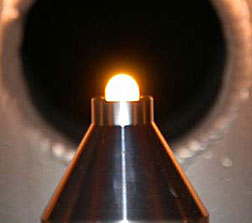- Number 379 |
- January 7, 2012
Aerodynamic levitator allows samples to 'float on air'

A metal oxide drop levitated in a flow of
high-purity argon gas. The sample is being
heated from above with a laser beam that
can heat it more than 2500 degrees
centigrade. The sample is held in a special
"levitation nozzle" installed in the NOMAD
beam line.
To study liquids and glasses, a collaborating team from Materials Development Inc.; Stony Brook University in New York; and DOE's Oak Ridge National Laboratory and Argonne National Laboratory has developed a container-less sample environment, in which a drop of pure liquid literally “floats” on a jet of flowing gas.
This aerodynamic levitator sample environment has been installed on the Nanoscale-Ordered Materials Diffractometer (NOMAD) at the Spallation Neutron Source at ORNL. There, the research team is using it to study small drops of liquids such as calcium, magnesium, and aluminum silicates.
“We study liquids as they transform to glass,” says Richard Weber, the principal investigator and the owner of Materials Development Inc. “That is important because many materials are processed as liquids at some stage in their life, such as silicon wafers that start as sand and then are converted into silicon by melting and processing. We look at the liquid state, measure its structure, and see how it actually transforms into glass."
Link to full story.
[Bill Cabage, 865.574.4399,
cabagewh@ornl.gov]
